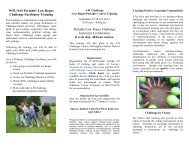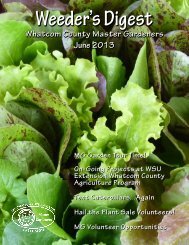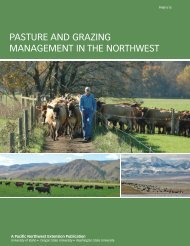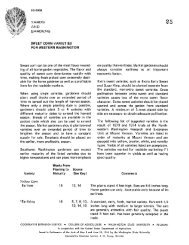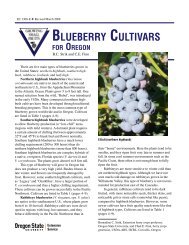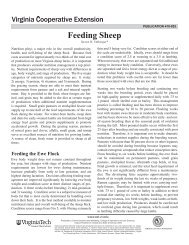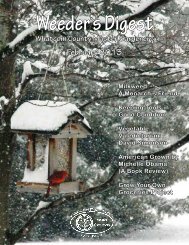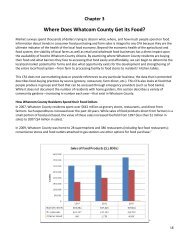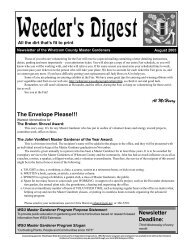Weeder’s DigestGarden Friends & FoesContinued from previous pageThe pestiferous tendency of the European paperwasp is found in its nestinghabits. P. dominulus appears to find human structures a favorable place to set up home.Often nests are constructed on roof eaves, decks, overhangs, doorways, outdoor lightfixtures, BBQ grills, birdhouses and mailboxes.Over all, the introduction of this highly successful wasp may impact our localecology. Some scientists are concerned that the European paperwasp will out-competenative wasps for nesting sites and food. Other concerns are for early season nativecaterpillars and other insects that the wasps prey on.Figure 4. Queen foraging for food andbuilding supplies (courtesy E.LaGasa)Figure 5. Mid-season nest with broodmaintaining the nest (courtesy E.LaGasa).Monitoring & ManagementIf possible, leave the nests alone. You will benefit from having these voraciouspredators working for you in your garden and landscape. In fact, entomologists atNorth Carolina are providing instructions on how to construct a ‘wasp box’ http://www.ces.ncsu.edu/depts/ent/notes/Other/note121/note121.html.In April and <strong>May</strong>, regularly check for nests in areas that are frequented often byyour family and mail carriers. If it can be done safely, remove the nest and dispose of it.I’ve done this on my eaves during mid-day when the queen was away and haven’t beenattacked. But please be careful when you do this; some people can be highly allergic towasp venom and it is not worth the risk. Nest removal is best done early in the seasonbefore the first brood hatches. Many times there will just be a single queen present.Prevention is key for keeping wasps out of wall voids, attic spaces and otherinterior habits. Seal any cracks, gaps and holes to prevent wasps from entering yourhouse. For air vents, install small-sized wire screen to prevent wasps and other crittersfrom entering. Wasps entering my house to overwinter was the only situation where Iwas stung by the European paperwasp. A wasp found my folded, winter blanket tocrawl into. It was quite a surprise to me the next time I used the blanket!Insecticides may be necessary if there is a fear of being stung or the nest is hardto reach and is in a problematic location. Aerosol cans of pyrethroid insecticides labeledfor wasp control will kill P. dominulus. See http://cru.cahe.wsu.edu/CEPublications/eb0643/eb0643.pdf for current recommendations. Many of these cans are constructedto deliver a precise stream of insecticide up to twenty feet away. Treat nests at nightwhen the paperwasps have returned to the nest. Leave the sprayed nest in place forseveral days. There will be residual activity and latecomers to the nest will be exposedto the insecticide. Read and follow the label directions carefully.Drs. Antonelli, Akre and Landolt have revised <strong>WSU</strong> EB 0643 Yellowjackets andPaper Wasps to include the European paperwasp. http://cru.cahe.wsu.edu/CEPublications/eb0643/eb0643.pdfTent Caterpillar Update~Todd MurrayThis year could be another good year (or bad year, depending onyour perspective) for tent caterpillars. If you work in any of the clinics, beprepared for many inquiries about tent caterpillars if it’s another outbreakyear. Please remember that fire is NEVER an appropriate recommendationfor managing tent caterpillars (or any other pest for that matter). Last year,when the outbreak became noticeable, newspapers, radio and televisionmedia offered some unfortunate information to the public. Recommendationssuch as, “Burn the tents with your flame weeder” were made. Soonafter, headlines like “Poulsbo Teen Burned While Trying To Destroy TentCaterpillars” started to appear. Eric LaGasa and I have put together a fewweb pages with pictures and information for people to learn more abouttent caterpillars. Visit (http://whatcom.wsu.edu/ag/homehort/pest/tent_caterpillar.htm). The web site should be up and running shortly.Hovander Happenings~David SimonsonOur Master Gardener Demonstration Gardenprojects are underway for the 2004 season! We areeager to have veterans come out to meet this year’sclass members. We are continuing with the projectswe’ve done before—but we plan a partial relocationof the native plant garden. It was flooded outlast winter, so it will be moved a little further uphill.Also, we plan to have a larger and improved cornmaze. Or, as Dick Steele would say, a maize maze!We will be working every Wednesday from 9till noon; and starting after the plant sale, Saturdaysfrom 9 till noon.
<strong>May</strong> 2004Weed of the Month ............................................ By Laurel ShinerButterfly BushBuddleja davidiiTHREAT: Butterfly bush, native to China, has become a very popular garden ornamental in NorthAmerica. However, it has escaped cultivation, invading roadsides, riparian areas,pastures, river gravel bars and other disturbed areas. Butterfly bush produces largequantities of wind and water dispersed seed (up to 3 million seeds per plant), which canremain dormant in the soil for many years. When cut down, it resprouts readily from therootstock and can be propagated through cuttings. Butterfly bush can reach maturityin less than one year, which allows it to spread quickly, forming dense thickets andexcluding native vegetation. Although this plant is touted as a beneficial plant forbutterflies, it cannot be used as a butterfly host plant and displaces the native plantsneeded by butterflies for reproduction. Butterfly bush is very adaptable, growing inmost soil types and climates. This plant has also become invasive in Europe, Australiaand New Zealand. Buddleja davidii is listed as noxious in Oregon.DESCRIPTION: Butterfly bush is a large deciduous shrub, growing up to 10 feet tall.Leaves are lance-shaped and opposite, up to 4 inches long and ½ inch wide. While thetops of the leaves are dark green in color, the undersides are given a light appearancefrom numerous whitish hairs. The leaves have small serrations along the edges. Thesmall, fragrant, funnel-shaped flowers are usually purple, although there are also red,pink, blue, orange, yellow and white varieties. The flowers are borne in showy spikesat the ends of the stems and bloom from mid-summer into the fall.MANAGEMENT OPTIONS: Butterfly bush can be controlled through mechanical andchemical means. Hand digging is possible for small numbers of plants or seedlings,although soil disturbance will encourage seeds in the soil to sprout. Controlled siteswill need to be monitored in subsequent years to ensure no new plants becomeestablished. Although mowing/cutting could be used to prevent seed production, theplants will resprout. Contact the weed control board for site-specific chemical recommendations.<strong>Whatcom</strong> <strong>County</strong> Noxious Weed Control Board, 901 W. Smith Rd., Bellingham, WA 98226, 360/354-3990Master Gardener Office:1000 N. Forest St., Suite 201Bellingham, WA 98225360/676-6736Weeder’s Digest is the monthly newsletter for the <strong>Whatcom</strong> <strong>County</strong> Master Gardener Program. Guest articles are encouraged. Please submittypewritten articles by the third Wednesday of each month to Karri at the Master Gardener Office. Articles can also be submitted by e-mail to:karrimac@coopext.cahe.wsu.edu. Editor uses MS Word for Windows and PageMaker 6.5. Any articles prepared on other programs or platformsshould be saved as Text Files or Rich Text Files. Editor reserves the right to edit for space considerations, grammar, spelling and syntax.Craig MacConnellHorticulture Agent



